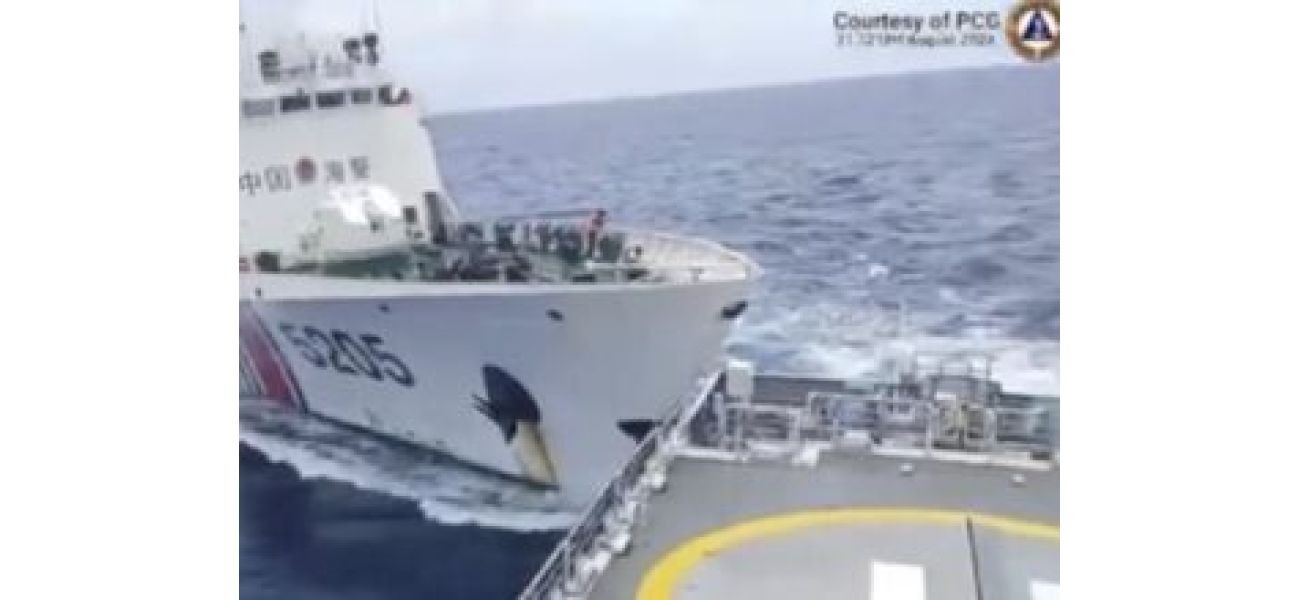Chinese and Philippine ships crash at disputed island.
China and the Philippines blame each other for a collision between their vessels in the South China Sea, further escalating tensions over disputed waters.
August 31st 2024.

In a recent event that has sparked tensions in the South China Sea, China and the Philippines have accused each other of causing a collision between their two vessels. The incident occurred on Saturday, leading to a heated exchange between the two nations over disputed waters and maritime features in the region.
According to Chinese coast guard spokesperson Liu Dejun, the Philippine ship maneuvered in an "unprofessional and dangerous manner" and deliberately collided with a Chinese coast guard ship. However, Philippine officials in Manila have refuted this claim, stating that it was their coast guard ship, the BRP Teresa Magbanua, that was rammed thrice by the Chinese coast guard without any provocation, causing damage to the Philippine vessel.
This is not the first confrontation between the two countries in the South China Sea. Just a few days ago, a similar incident occurred near Sabina Shoal, which is located about 140 kilometers west of the Philippine province of Palawan. The area is within the internationally recognized exclusive economic zone of the Philippines, adding to the complexity of the situation.
The Philippine ship involved in the collision, the Magbanua, had been anchored in Sabina Shoal since mid-April, following suspicions from Manila that China may construct a structure to seize the uninhabited atoll. On the other hand, China also had similar suspicions and had recently filed a diplomatic protest against the Philippines due to the prolonged presence of the ship in the area.
It is worth noting that this dispute is not just between China and the Philippines, as other claimants including Vietnam, Taiwan, Malaysia, and Brunei are also involved in the longtime territorial disputes. The tensions have escalated in recent years due to China's rapid military expansion and increased assertiveness in pursuing its claim to virtually the entire South China Sea, an important international trade route.
In response to the collision, the United States has condemned China's actions and expressed its support for the Philippines in upholding international law. The U.S. Ambassador to Manila, MaryKay Carlson, stated that they stand with the Philippines and are obligated to defend them under a treaty if they come under armed attack in the South China Sea.
In the midst of these tensions, there have been discussions about the possibility of the U.S. escorting Philippine ships in the disputed waters. However, China's coast guard, navy, and accompanying ships have regularly clashed with Philippine vessels during attempts to resupply Filipino sailors stationed in parts of the South China Sea claimed by both countries. This has led to injuries and damage to Philippine ships, raising questions about invoking the treaty alliance with the U.S.
Apart from the incident in the South China Sea, Japan has also lodged a formal protest against China for an incursion by a Chinese survey ship into its territorial waters. This has added to Japan's concerns about the growing military cooperation between China and Russia. However, China has stated that they have no intention of violating any country's airspace.
As tensions continue to rise in the region, it is crucial for all parties involved to find a peaceful resolution to these disputes. The recent agreement between China and the Philippines to prevent further confrontations at Sabina Shoal is a step in the right direction, and it is hoped that more efforts will be made to maintain stability in the South China Sea.
According to Chinese coast guard spokesperson Liu Dejun, the Philippine ship maneuvered in an "unprofessional and dangerous manner" and deliberately collided with a Chinese coast guard ship. However, Philippine officials in Manila have refuted this claim, stating that it was their coast guard ship, the BRP Teresa Magbanua, that was rammed thrice by the Chinese coast guard without any provocation, causing damage to the Philippine vessel.
This is not the first confrontation between the two countries in the South China Sea. Just a few days ago, a similar incident occurred near Sabina Shoal, which is located about 140 kilometers west of the Philippine province of Palawan. The area is within the internationally recognized exclusive economic zone of the Philippines, adding to the complexity of the situation.
The Philippine ship involved in the collision, the Magbanua, had been anchored in Sabina Shoal since mid-April, following suspicions from Manila that China may construct a structure to seize the uninhabited atoll. On the other hand, China also had similar suspicions and had recently filed a diplomatic protest against the Philippines due to the prolonged presence of the ship in the area.
It is worth noting that this dispute is not just between China and the Philippines, as other claimants including Vietnam, Taiwan, Malaysia, and Brunei are also involved in the longtime territorial disputes. The tensions have escalated in recent years due to China's rapid military expansion and increased assertiveness in pursuing its claim to virtually the entire South China Sea, an important international trade route.
In response to the collision, the United States has condemned China's actions and expressed its support for the Philippines in upholding international law. The U.S. Ambassador to Manila, MaryKay Carlson, stated that they stand with the Philippines and are obligated to defend them under a treaty if they come under armed attack in the South China Sea.
In the midst of these tensions, there have been discussions about the possibility of the U.S. escorting Philippine ships in the disputed waters. However, China's coast guard, navy, and accompanying ships have regularly clashed with Philippine vessels during attempts to resupply Filipino sailors stationed in parts of the South China Sea claimed by both countries. This has led to injuries and damage to Philippine ships, raising questions about invoking the treaty alliance with the U.S.
Apart from the incident in the South China Sea, Japan has also lodged a formal protest against China for an incursion by a Chinese survey ship into its territorial waters. This has added to Japan's concerns about the growing military cooperation between China and Russia. However, China has stated that they have no intention of violating any country's airspace.
As tensions continue to rise in the region, it is crucial for all parties involved to find a peaceful resolution to these disputes. The recent agreement between China and the Philippines to prevent further confrontations at Sabina Shoal is a step in the right direction, and it is hoped that more efforts will be made to maintain stability in the South China Sea.
[This article has been trending online recently and has been generated with AI. Your feed is customized.]
[Generative AI is experimental.]
0
0
Submit Comment





